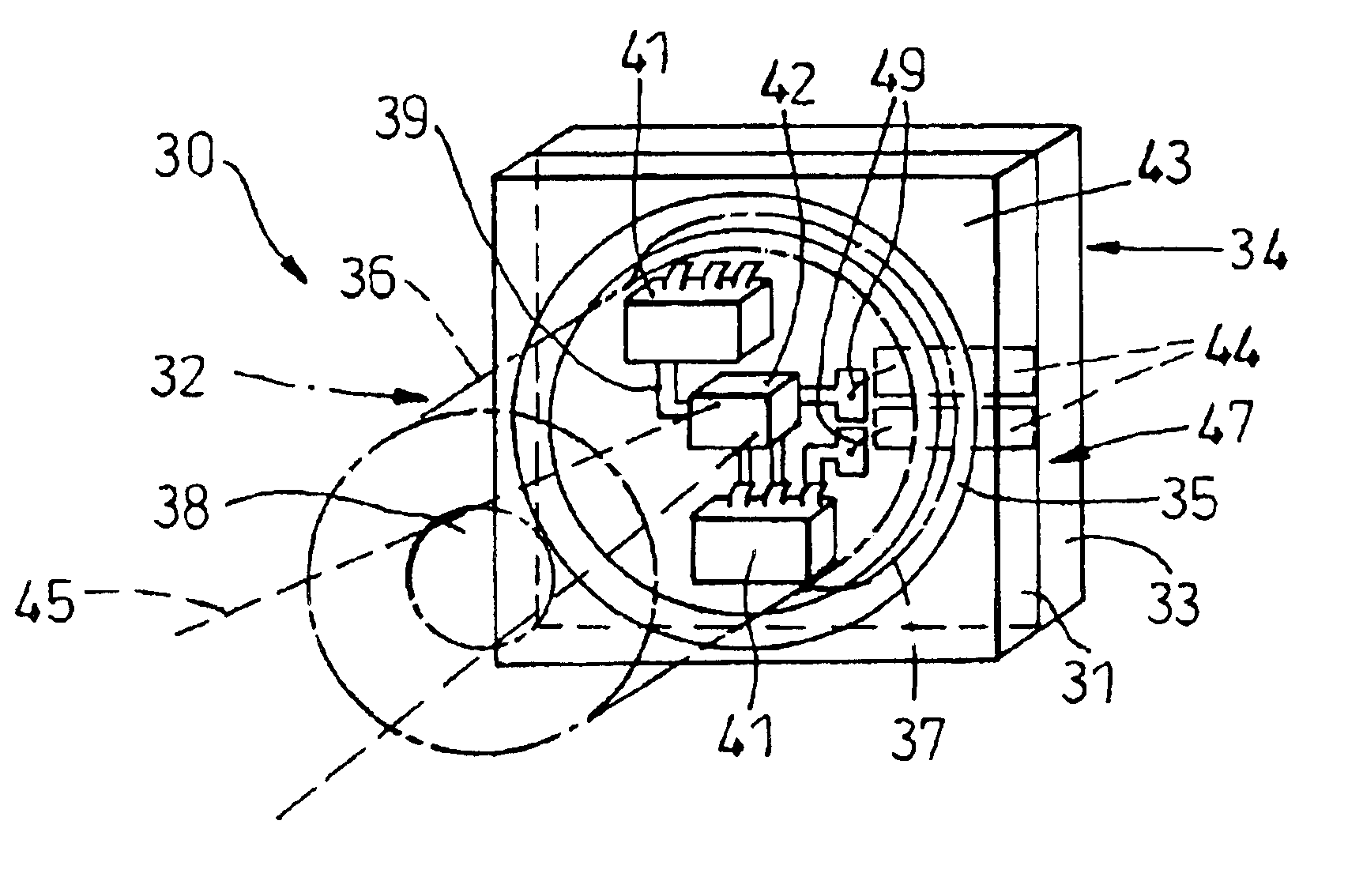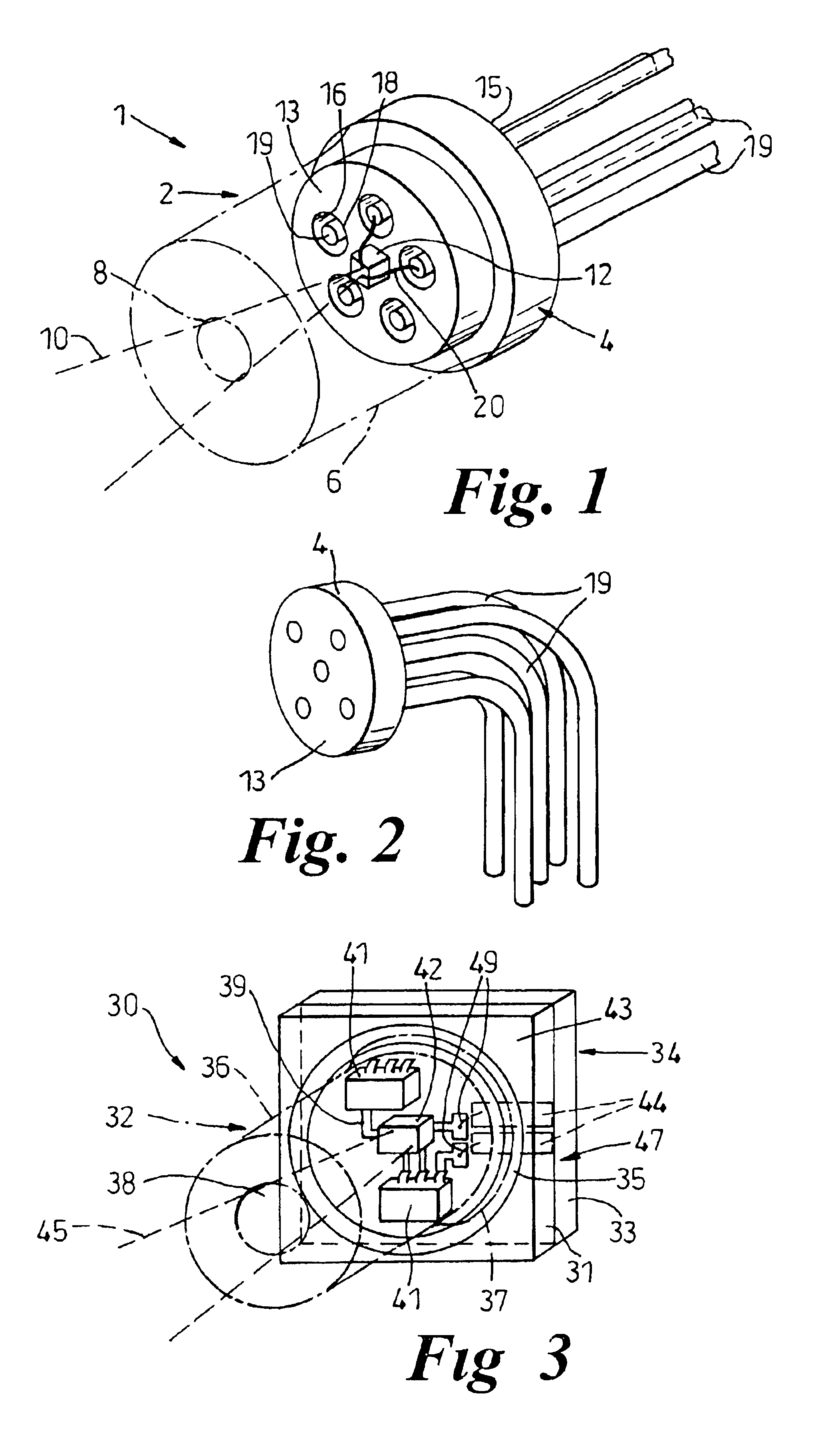Optoelectronic package
a technology of optoelectronic and package, applied in the direction of semiconductor lasers, semiconductor/solid-state device details, instruments, etc., can solve the problems of lack of design flexibility, limited high-frequency performance, electrical connections to such components, etc., and achieve the effect of facilitating electrical connections
- Summary
- Abstract
- Description
- Claims
- Application Information
AI Technical Summary
Benefits of technology
Problems solved by technology
Method used
Image
Examples
first embodiment
FIG. 3 shows an optoelectronic device 30 according to the invention, comprising a housing 32 in the form of a TO-style coaxial package with a generally cylindrical metal canister 36 bonded to a square multi-layer insulating ceramic base 34. The canister 36 has a circular window 38 for allowing optical radiation 45 to pass into or out of the canister on its way to or from at least one optoelectronic component 42 within the canister 36.
The base has an upper surface 43 with a number of metalised areas, including an annular metalised ring 35 to which an open circular end 37 of the canister 36 is bonded, for example by soldering, brazing or projection or laser welding.
The canister 36 is shown in phantom outline so that various internal components within the housing 32 can be seen. These components include the optoelectronic component 42 which is mounted on the upper surface 43 of the ceramic base 34. The optoelectronic component 42 is connected to other electronic components 41 by metali...
third embodiment
FIG. 5 shows an optoelectronic device 60 according to the invention. The device 60 is similar to that of the device 50 shown in FIG. 4, having a cylindrical metal canister 66 and a single layer ceramic base 64 forming a housing 62, but instead of a window 58 has an optical port in the form of a socket 68 into which is plugged a fibre optic connector 61 for a pluggable patch or alternatively modified for a fibre pigtail 69 that carries optical radiation 65 to or from the optical port 68.
fourth embodiment
FIG. 6 shows an optoelectronic device 70 according to the invention. The device 70 is similar to the device 30 of FIG. 3, comprising a housing 72 with an insulating ceramic substrate 74 bonded to a metal canister 76 that has a central circular window 78. Optical radiation 75 may pass through the window 78 on its way to or from the housing 72. The ceramic substrate 74 may be single-layer or multi-layer, and extends laterally away from the housing 72 to facilitate a connection with a printed circuit board (pcb) 71. Electrical tracks 79 may be provided on either side 73,77 of the ceramic base 74 to make electrical connections with the pcb 71. The tracks 79 may terminate in through pins for solder connection to matching through holes in the pcb 71. Alternatively, the tracks 79 may wrap around the end of the substrate 74 for surface mount soldering to the pcb 71. Tracks 79 on the same side 73 of the base 74 as the metallic canister 76 may pass under the canister 76 if there is an interve...
PUM
 Login to View More
Login to View More Abstract
Description
Claims
Application Information
 Login to View More
Login to View More - R&D
- Intellectual Property
- Life Sciences
- Materials
- Tech Scout
- Unparalleled Data Quality
- Higher Quality Content
- 60% Fewer Hallucinations
Browse by: Latest US Patents, China's latest patents, Technical Efficacy Thesaurus, Application Domain, Technology Topic, Popular Technical Reports.
© 2025 PatSnap. All rights reserved.Legal|Privacy policy|Modern Slavery Act Transparency Statement|Sitemap|About US| Contact US: help@patsnap.com



